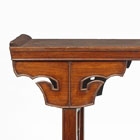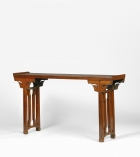J.J. Lally & Co., Oriental Art / New York City, New York
MenuPast Exhibition
Chinese Art from the Scholar’s Studio
March 13 - April 11, 2015
71.
A HUANGHUALI TABLE WITH ‘TAOTIE’ SPANDRELS
17th – Early 18th Century
the single-plank solid top with quarter-round flanges at the narrow ends, embellished with a wide beaded border on the upper edge and fine rounded beading on the lower edge above spandrels of highly unusual design, resembling an ancient bronze taotie mask motif, the straight legs resembling a sheathed sword, ending in block feet and joined by humpback stretchers.
62 1⁄2 x 33 5⁄8 x 13 5⁄8 inches
Provenance
Private Collection, Florida
Eskenazi Ltd., London
This table is a superb example of a style and construction found only in furniture made in Fujian province. The unusual joinery, using dramatic wide spandrels without any apron, joined flush to the legs by sliding over a dovetail tenon at the top of each leg, is unique to furniture from Fujian, and the bold humpback stretchers are typical of the finest furniture from the Fujian region.
It is interesting to note that in most of the known examples of altar tables constructed without aprons the spandrels are placed at the extreme ends of the top, as seen in this example, not recessed as is more commonly seen on altar tables with aprons. Compare, for example, the tieli wood long altar table, also from Fujian, illustrated in Flacks, Classical Chinese Furniture, London, 2011, pp. 210-211.
Compare also the longyan wood table with spandrels and construction similar to the present example, illustrated by Ang in “Further Studies of Chinese Furniture in Various Woods: Longyan Wood Furniture”, Arts of Asia, September-October 2004, p. 71, no. 19, where the author notes that “Several of such tables in longyan and other woods have appeared on the market showing that at one time they were quite popular in Fujian.”
十七-十八世紀初 黃花梨翹頭案 158.8 x 85.4 x 34.6 厘米

